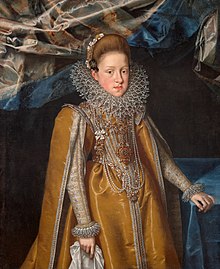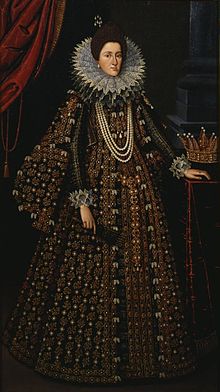Maria Magdalena of Austria (1589–1631)

Maria Magdalena of Austria (Italian Maria Maddalena d'Austria ; born October 7, 1589 in Graz , † November 1, 1631 in Passau ) from the House of Habsburg was an Archduchess of Austria and by marriage Grand Duchess of Tuscany . From 1621 to 1628 she was regent of the Grand Duchy for her eldest son Ferdinando II de 'Medici .
Life
Origin and youth
Maria Magdalena was the youngest daughter of Archduke Karl II of Inner Austria-Styria (1540–1590) and his wife Princess Maria Anna of Bavaria (1551–1608), the eldest daughter of Duke Albrecht V of Bavaria and Archduchess Anna of Austria . She was a sister of the future Roman-German Emperor Ferdinand II and the Spanish Queen Margaret . Maria Magdalena was raised Catholic and strictly counter-reformist by her mother. She received a thorough education and showed keen interest in contemporary art and humanism .
On October 19, 1608, 19-year-old Maria Magdalena married Grand Duke Cosimo II. De 'Medici (1590–1621), son of Grand Duke Ferdinand I of Tuscany and Princess Christine of Lorraine, of about the same age in Padua . This marriage was politically motivated and was intended to bring about a marriage alliance between the Medicis and the Austrian monarchy. The marriage was celebrated in great splendor and the young couple received several poetic appreciations. The marriage was considered happy, but the art-loving Cosimo died at the age of 31.
Regent of Tuscany
After the death of her husband in 1621, Maria Magdalena's eldest son Ferdinand - then 11 years old - succeeded him in the government, whereby, according to Cosimo's testamentary decree, he was placed under Mary Magdalene and her mother-in-law's guardianship, who were in turn assigned four councilors. Christofano Bronzini mentions in his treatise Della dignitá e nobilitá delle donne , dedicated to the Grand Duchess in 1622 , that the woman was created by God to be the mistress of the man, which brought the work to the papal index. Maria Magdalena was considered to be the patron of the singer and composer Francesca Caccini .
The reign of Mary Magdalene and her co-rulers is considered to be the beginning of the period of decline in the history of the Grand Duchy. Mary Magdalene was seen as bigoted and wasteful. Excessive donations to convents and monasteries had a catastrophic effect on public finances. While Maria Magdalena ruled pro-Austria, her co-regent Christine tended towards France-friendly politics.
After the victory of the Catholic camp in the Battle of the White Mountain , which was made possible by Tuscan auxiliaries, Maria Magdalena had the facade of the Villa Medici Poggio Imperiale near Florence , which she acquired in 1622, decorated with the Habsburg coat of arms and inside with fresco cycles by the painter Matteo Rosselli which symbolically represent the victory of “Pietas Austria” over “heretics and rebels”. These cycles also deal with the life and deeds of her deceased husband, the praise of the Habsburgs and scenes from the lives of biblical heroines and Christian martyrs and rulers.
Last years
Like her husband and her son, Maria Magdalena was considered to be a patron of Galileo Galileo . She was portrayed by the Flemish painter Justus Sustermans , among others . Maria Magdalena viewed the neutrality policy of her son's Italian states, which was promoted during the Thirty Years' War , very critically.
During the reign of her son, Mary Magdalene presented him with a long list of the names of well-known Florentine homosexuals and demanded their death by fire. To his mother's horror, Ferdinand added his own name and threw the paper into the chimney with the remark “ You see, Signora - your sentence has already been carried out ”.
The Grand Duchess went on a trip north in 1631 when she was invited by her brother, Emperor Ferdinand II . But she died at the age of 41 after a visit by her brother Leopold in Innsbruck on the way to Vienna in Passau and was buried in the Basilica di San Lorenzo di Firenze . Like her sisters, Maria Magdalena was endowed with a distinct shape of the Habsburg lower lip , which she potentiated and consolidated into the Medici family .
progeny
From her marriage to Cosimo II. De 'Medici, Maria Magdalena had the following eight children:
- Maria Christina (* August 24, 1609; † August 9, 1632)
- Ferdinand II (born July 14, 1610, † May 23, 1670), Grand Duke of Tuscany
- ⚭ 1634 Princess Vittoria della Rovere , heiress of the Duchy of Urbino (1622–1695)
- Giancarlo (July 24, 1611 - January 23, 1663), cardinal since 1644
- Margherita (born May 31, 1612 - † February 6, 1679)
- ⚭ 1628 Duke Odoardo I Farnese of Parma and Piacenza (1612–1646)
- Mattias (born May 9, 1613 - October 11, 1667), governor of Siena since 1629
- Francesco (October 16, 1614 - July 25, 1634)
- Anna (July 21, 1616 - September 11, 1676)
- ⚭ 1646 Archduke Ferdinand Karl of Austria-Tyrol (1628–1662)
- Leopoldo (6 November 1617 - 10 November 1675), cardinal since 1667
literature
- Constantin von Wurzbach : Habsburg, Maria Magdalena (Duchess of Florence) . No. 248. In: Biographisches Lexikon des Kaiserthums Oesterreich . 7th part. Kaiserlich-Königliche Hof- und Staatsdruckerei, Vienna 1861, pp. 56–58 ( digitized version ).
- Estella Galasso Calderara: La granduchessa Maria Maddalena d'Austria: un'amazzone tedesca nella Firenze medicea del '600 , Genoa 1985
- Maria Magdalena , in: Brigitte Hamann (Ed.): Die Habsburger , 1988, p. 338 f.
- Adam Wandruszka : Maria Magdalena, Archduchess of Austria. In: New German Biography (NDB). Volume 16, Duncker & Humblot, Berlin 1990, ISBN 3-428-00197-4 , p. 206 f. ( Digitized version ).
- Lorenzo DeMedici: The Medici: The story of my family , Bastei Lübbe, 2008, p. 181 f.
- V. Arrighi: MARIA MADDALENA d'Austria, granduchessa di Toscana. In: Mario Caravale (ed.): Dizionario Biografico degli Italiani (DBI). Volume 70: Marcora – Marsilio. Istituto della Enciclopedia Italiana, Rome 2007, pp. 260-264.
Web links
- Literature by and about Maria Magdalena of Austria in the catalog of the German National Library
- http://www.sehepunkte.de/2010/04/15317.html
Individual evidence
- ^ David Klemm: Stefano della Bella (1610-1664) , Böhlau Verlag Köln Weimar, 2009, p. 8
- ↑ Linda Maria Koldau : Frauen-Musik-Kultur , Böhlau Verlag Köln Weimar, 2005, p. 103
- ↑ Anne-Marie Bonnet, Barbara Maria Schellewald: Women in the Early Modern Age: Lifestyles in Art and Literature , Böhlau Verlag Köln Weimar, 2004, p. 235
- ^ Maria Magdalena , in: Brigitte Hamann (Ed.): Die Habsburger , 1988, p. 338 f.
- ↑ James Cleugh: The Medici , Bechtermünz, 1996, p. 346
- ↑ Archived copy ( memento of the original from January 21, 2017 in the Internet Archive ) Info: The archive link was inserted automatically and has not yet been checked. Please check the original and archive link according to the instructions and then remove this notice.
- ↑ German Society for Race Hygiene: Archive for Race and Society Biology including Race and Society Hygiene , Volume 8, F. Lehmanns Verlag, 1911, p. 779
| personal data | |
|---|---|
| SURNAME | Maria Magdalena of Austria |
| BRIEF DESCRIPTION | Archduchess of Austria, by marriage Grand Duchess of Tuscany |
| DATE OF BIRTH | October 7, 1589 |
| PLACE OF BIRTH | Graz |
| DATE OF DEATH | November 1, 1631 |
| Place of death | Passau |
